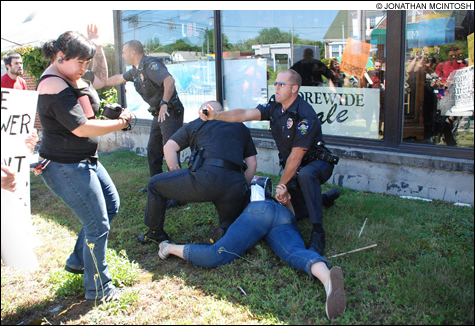
ON THE MARCH: This image [top] of Svoboda’s injured leg inspired broad sympathy.
|
A sense of taking it to the Man was in the air as some 200-plus supporters of Alexandra Svoboda rallied last Sunday afternoon in front of North Providence High School. A series of speakers expressed fierce solidarity with Svoboda, the 22-year-old woman who had been seriously injured during an August 11 protest in the town. The demonstrators whooped, cheered, banged on makeshift drums, and waved a variety of signs. Banners featuring the iconic black cat of the Industrial Workers of the World (IWW) fluttered in the humid August air.
IWW organizers called the event a success. It went off without a hitch, as a handful of state troopers and North Providence officers stood on the periphery, and received prominent front-page play on the next day’s Providence Journal. If nothing else, the demonstration marked an outpouring of support for Svoboda, who, after three leg surgeries, still faces the reconstruction of her injured knee. Coming about a week before Labor Day, it also marked a bit of vitality on the left end of the labor movement.
Still, considering how the IWW has mostly been a barely perceptible entity since its pre-World War I heyday, one has to wonder whether the protest at North Providence High will mark a contemporary high point for the union in Rhode Island.
While the extent of Svoboda’s injuries — her father says he is unaware of any athlete who has suffered similar leg damage — sparked widespread sympathy for the transplant from Nebraska, the 35-member size of the IWW’s local chapter does not exactly signal a robust movement.
Some in the local movement welcome an additional voice for workers’ rights, yet even those with a philosophical appreciation for the Wobblies’ original vision of “one big union” question the IWW’s staying power. As Robert Walsh, executive director of the National Education Association Rhode Island, says, “They’re kind of the new kid on the block. I don’t know if this is going to be a 15 minutes of fame kind of thing.”
Local IWW organizer Mark Bray, a 24-year-old Providence College grad student with a calm, methodical demeanor, is keenly aware of how the union has to deliver results, not rhetoric. While it’s premature to offer specifics, Bray says, IWW is pursuing several local campaigns, and it has attracted more interest from potential members after the August 11 conflict.
A big part of the union’s success will depend on its ability to extend an appealing message. Not coincidentally, while critics point to the IWW’s historic identification with the radical left, Bray says, “We are not a communist organization, or a socialist organization, or anything ‘ist’ ” Democracy in the workplace, he says, is “perhaps our most important value.”
The activist perceives a lot of opportunity for organizing workers without having to compete with other unions. “We’re trying to fill the gap in the labor movement, which was the original purpose of the IWW,” says Bray.
As in other places where the Wobblies are active, the union hopes to improve workplace conditions while helping workers to keep their jobs. “If the union can get a few dominoes going,” in terms of successful efforts, Bray believes, “then we have a bright future ahead of us.”